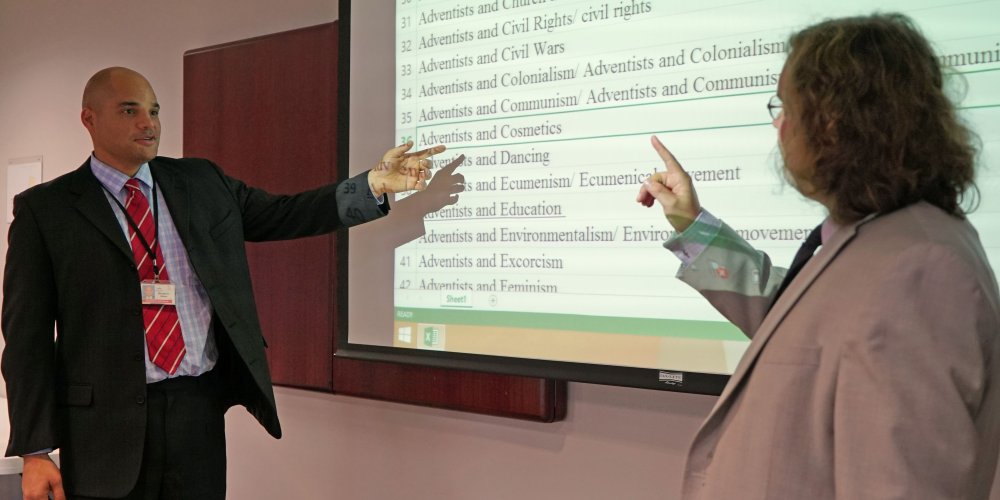
Spies are in. Subcultures are out. And cosmetics and dance belong together in a single article titled “Lifestyle.”
These were among the decisions made this week as a 26-member editorial committee behind the new Encyclopedia of Seventh-day Adventists gathered for the first time to fine-tune topics and adjust the vision of the $1.6 million, five-year project.
The online encyclopedia, which will replace the bound Seventh-day Adventist Encyclopedia first published in 1966, is a global church endeavor that will see thousands of members participate by researching, writing articles, editing, and sharing memories, documents, artifacts, and other information.
The Encyclopedia of Seventh-day Adventists will start publishing its estimated 10,000 articles online as they become available, starting in 2017. The full encyclopedia will debut at the 2020 General Conference Session, although its online presence will ensure that it is continually updated and amplified.
“We keep discovering how much bigger the project is than we first imagined,” encyclopedia editor David Trim said after the editorial committee met for three days at the General Conference’s headquarters in Silver Spring, Maryland. “But that is partly because we also keep realizing how much more could be done, using the power of technology, for example.”
The editorial committee, comprised primarily of historians and representing the Adventist Church’s 13 world divisions, spent hours finalizing the list of topics for the encyclopedia and discussing which articles would be retained from the old encyclopedia, which was most recently revised in 1996. The committee decided that all biographies and most other articles would be written new, while some short articles on administrative entities could be simply updated with new dates and data.
“But at the moment I would estimate that 90 percent of articles will be newly written. This will be one of the strengths of the encyclopedia,” said Trim, who serves as director of the General Conference’s Office of Archives, Statistics, and Research.
The online encyclopedia has roots in a 2010 proposal by the Adventist Review and Adventist World to create a Wikipedia-style website with crowd-sourced information, and the two magazines are participating in the ongoing project.
The magazines now will encourage congregational and crowd-sourced histories of local churches, Adventist institutions, and individuals who will not be the subject of separate articles in the encyclopedia, while the effort by the Office of Archives, Statistics, and Research will focus on scholarly contributions to understanding Adventist history and experience.
“When the project to develop a new Seventh-day Adventist encyclopedia was initiated, it quickly became apparent to all parties that partnering was a way to bring the enthusiasm and artifacts of thousands of readers to the goal of building a fuller historical record of the church’s institutions, leaders, and ministries,” said Bill Knott, editor of Adventist Review and Adventist World.
The two magazines will serve as the entry portal for thousands of church members aware of information that professional historians and archivist probably don’t know — through letters, diaries, photographs, audio and video recordings, and locally developed histories of churches and schools, Knott said.
“Starting with the journals’ two major websites, readers will be able to interact with other readers, upload documents and photos, and enrich the church’s conversation about how the Lord has led us in our past history,” he said.
Read also: Adventist Church Will Release All-New Encyclopedia
Members of the Encyclopedia of Seventh-day Adventists editorial committee hold the title of assistant editor and comprise mostly current or retired church employees, including former South Pacific Division president Barry Oliver and DeWitt Williams, former health ministries director for the North American Division.
The new assistant editors — who are primarily divided into two types, regional and thematic — acknowledged in interviews that they face a formidable task but expressed an eagerness to get to work.
“I don’t think we fully grasp how extensive this is going to be,” said Glenn Phillips, history professor at Morgan State University in Baltimore, Maryland, who is overseeing the English, Dutch, and French regions of Inter-America for the encyclopedia.
He spoke of the challenges of editing and possibly rewriting articles.
Lisa Clark Diller, history professor at Southern Adventist University, said she looked forward to engaging students in research in thematic topics, including possibly “Boarding Schools” and “Adventists and Espionage.”
“I am really excited about this project,” Diller said. “I think it’s a great way to get my students writing and thinking about their Adventist heritage.”
“Adventists and Espionage” is a topic that Diller proposed and the committee accepted this week. Diller said she knew of Adventist young men who grew up in missionary families and were recruited by spy agencies because they were international, knew multiple languages, and were clean living.
“I think this is a topic that people will find very interesting,” she said.
The committee rejected the topic of subcultures of Adventism, deciding that the information would be placed in more specialized articles. Its members discussed at length whether there needed to be separate articles on cosmetics, dance, and similar topics but ultimately agreed on one article on lifestyle.
Chigemezi Wogu, a research assistant from Friedensau Adventist University in Germany, said he was happy just to be part of the project. Wogu attended this week’s meeting on behalf of a committee member from the Inter-European Division.
In the runup to the meeting, he was generating a list of potential article topics. The committee approved his topic “Adventism and Post-Christian Europe.”
“This is an issue that must be discussed,” Wogu said.
Wogu also noted with a smile that he was the youngest person at the meeting. He is 26.